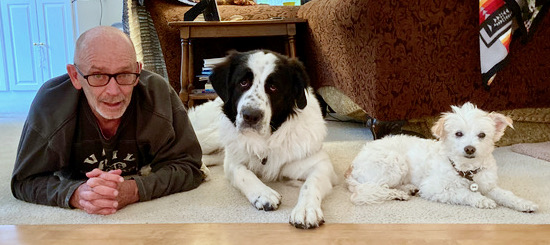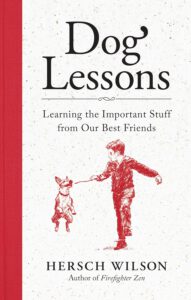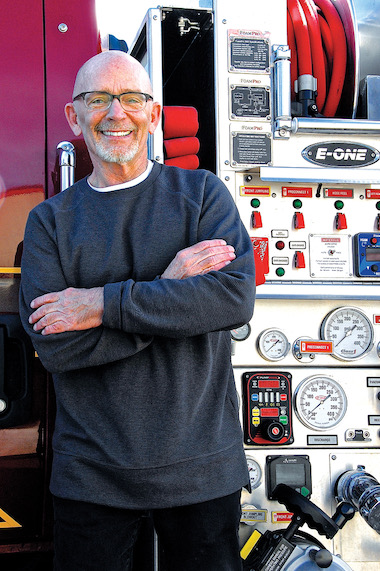Love dogs? You’ll love this book!
By DAVID CRUMM
Editor of ReadTheSpirit magazine
I read this entire book aloud to my wife, cover to cover, during a road trip in which she drove, I read—and together we smiled, sometimes laughed and even cried a few times. Why the tears? Because dogs’ lives are so short in comparison with ours, most dog books involve the passing of a beloved companion—and this one does, as well.
Reading an entire book aloud is exceedingly rare for us.
And, that’s why I’m certain that—if you’re a dog lover like we are—you will want to get a copy of this book. You’ll fall in love so quickly that, like us, you’ll feel compelled to share passages with a friend or loved one. Here’s a quick test: If you’ve ever enjoyed James Herriot’s autobiographical books or either of the two TV series made from his writings—you’ll definitely enjoy Hersch Wilson’s new Dog Lessons: Learning the Important Stuff from Our Best Friends.
In an interview with Hersch about this new memoir, I told him about another writer I worked with a decade ago. John Gillis was a larger-than-life Midwest radio personality whose home base was Indianapolis, Indiana. John wanted to write a memoir and, as we talked about how to structure such a book, I was struck by how deeply he and his dogs had shaped each other’s lives. Like Hersch, John discovered the wonders of dogs while growing up in the rural Midwest, which meant that John always was accompanied by fairly large dogs, also like Hersch. And, like Hersch’s four-pawed friends, John’s dogs were far more than “pets”—they defined each season of John’s colorful life.
Finally, as we talked about his dogs, I told John: “How about writing a five-part memoir called My Life in 5 Dogs?”
He loved the idea! Unfortunately, 11 years ago, before he had written much, John died.
One reason my wife and I responded so whole-heartedly to Hersch’s memoir is that Hersch essentially has written what I would call My Life in 18 Dogs.
When I told John’s story to Hersch, he nodded across the Zoom screen.
He said, “I like that. But for me, it’s My Life in 18 Dogs. That really is the idea of this book: I tell how each one of those 18 relationships has taught me something important about love and loyalty—and so many other things.”
I told Hersch that I read his entire book aloud, because we fell in love with the first section of the book about his childhood. “After the first 20 pages, we were hooked on reading the whole thing like this—me reading and both of us enjoying the stories,” I told him. “I think you organized this book perfectly by starting with those childhood experiences.”
“I think you’re right about the book’s structure,” he said. “It’s because those early stories in the book are filled with an almost miraculous relationship between a boy and a dog. That’s how I learned to trust a dog and let a dog take me into the wilderness and really see and experience the wilderness. From that start, I wanted to have a dog with me for the rest of my life.”
My wife and I feel the same way.
If you do, then this book could be the next big smile (with a few tears here and there) that you’ll want to enjoy this autumn.
Who Is Hersch Wilson?
When New World Library mailed me a review copy of Hersch’s book, the other thing that intrigued me—beyond the subject of dogs—was the quirky “bio” of the author: “Hersch Wilson is an organizational consultant, pilot, former professional dancer, newspaper columnist, and volunteer firefighter. He lives in Santa Fe, New Mexico, with his wife, Laurie; two daughters; and two dogs, a Great Pyrenees and a Chihuahua-terrier mix.”
When I Googled Hersch to learn more about him, one of the first photos that popped up showed him standing proudly next to the instrument panel of a fire truck. That’s an image he used to promote his 2020 memoir, Firefighter Zen: A Field Guide to Living in Tough Times.
For all of the surprising professional twists and turns Hersch has followed over the years, his instinct as a master storyteller is to compartmentalize and focus each of his book-length narratives. For example, I own a copy of Firefighter Zen and can recommend that book as well—but there’s very little about Hersch’s life with dogs in that book. There’s one exception in Firefighter Zen, a horrifying true story mid-way through that memoir about a house fire to which Hersch’s volunteer firefighter crew responded in which dogs perished. As you can imagine, that’s one of the most haunting memories from Hersch’s career in firefighting.
And, then, this new book is laser focused as well. It includes almost nothing about firefighting.
In weighing which stories to include, this time, he chose only those involving dogs. Another example of this focus: Readers of this new book learn almost nothing about Hersch’s main “family business.” As he was growing up, Hersch’s father was a salesman and became a nationally known pioneer in corporate training programs. Following his father’s example, Hersch has “paid the bills” for years through his own work in developing training programs and other forms of corporate consulting.
“For years, we had a company that developed courses, training and leadership consulting,” Hersch said in our interview. “We were pioneers in building ropes courses back in the ’80s, when that became very popular in corporate training. And, then, I worked in consulting all over the world until the big crash in 2008, when everything seemed to slow down. Fortunately, my wife Laurie started a retail store in Santa Fe that’s done great business in recent years. So, we’ve paid the bills over the years in a variety of ways.”
If you’re passing through Santa Fe, you may want to check out Laurie’s award-winning Teca Tu Pawsworthy Pet Emporium. (Visit the shop’s website and you’ll find a few more photos of the Wilsons’ dogs as well.)
Oh—and are you still wondering about the “professional dancer” part of Hersch’s life? Well, first of all, that’s not a fanciful exaggeration. Hersch was a professional dancer in the U.S. and Europe during his 20s. It’s barely mentioned in this new book—but, someday, I’ll certainly be among the first to buy a copy of Hersch’s memoir about a dancer’s life.
If you’re wanting to read some of Hersch’s writing immediately, you also can check out The Santa Fe New Mexican website, where he occasionally appears as a columnist.
The Tricky Business of Describing Dogs
As I mentioned in the opening of this column, my wife and I are fascinated by animals, especially dogs, and we read a lot about animal-human relationships. If you have read this far in this column, you probably are aware that, today, there is a debate among humans about what words best describe our relationships with the animals we welcome into our homes.
“I like the phrase ‘dog guardian.’ I don’t mind the word ‘pet;’ that doesn’t bother me. But I like to use the word guardian because it explains clearly that we are the guardians of our dogs,” Hersch told me. “I don’t use the phrase ‘dog owner,’ because the word ‘owner’ implies that you can do anything you want with what you own. If I own a car, but don’t like it anymore, I can get rid of it. No problem. I own the car. But dogs aren’t cars. They feel pain and joy and think. They’re sentient beings and it becomes our responsibility to protect them and give them as happy a life as we can possibly give them. Their lives are short. We have a big responsibility to them. That’s wholly different than owning something.”
I told Hersch that I would include a link to his Santa Fe newspaper columns.
“Well, if people do read those columns, you’ll see that I talk a lot about what it means to be a guardian. It means two important things: You’ve stopped taking dogs for granted and you’re trying to understand and communicate with your dog. Dogs can use language in ways that we’ve never imagined before. I’m not a scientist, but it’s clear that we are in a renaissance of studies about dog cognition and ways that we can understand dogs. My job as a columnist is to simplify and explain that research so others can understand what we can learn.”
“And that’s really the central theme of this book as well: Appreciating what we can learn from our dogs,” I said.
“Yes, that’s right,” he said. “Even though we are seeing a lot of new research today, the power of the dog-human relationship goes back thousands of years. I’m in a part of the country where we are reminded of the indigenous wisdom from which we also can learn. I talk in the book about how I live just five miles from Arroyo Hondo Pueblo, a historical site where skeletons of humans have been found with their dogs. These relationships were part of indigenous life and I find that indigenous culture can teach us a lot about the larger relationship we have with our natural world—whether we appreciate it or not.”
“You’re also emphasizing that building a relationship with a dog takes a lot of care and time and energy and patience, right?” I asked.
“That’s right,” he said. “And I hope people will consider thinking about whether they can adopt a dog—and, if they feel they can—then start by considering shelter or rescue dogs. These dogs, depending on what their experiences have been, may take even more time and patience and commitment—but I can tell you: Building a lifetime relationship with a dog can be one of the best experiences you’ll ever have in your life.”
.
.



